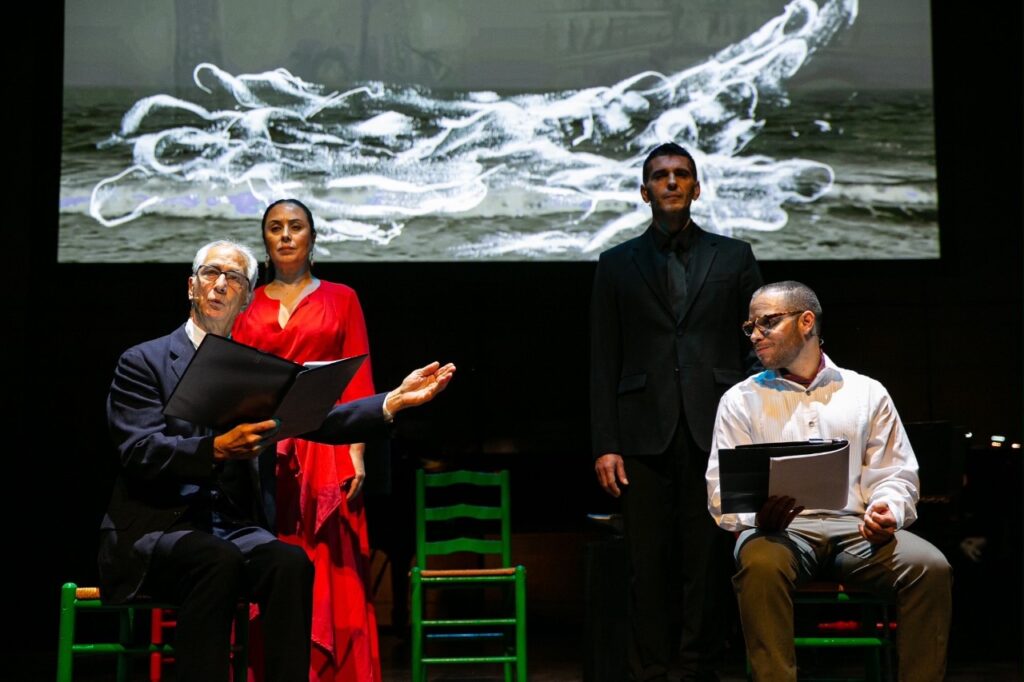PostClassical Ensemble Fills Stage With Falla
By • May 1, 2023 0 1640

Though he is probably the best-known Spanish composer, in this country Manuel de Falla isn’t a marquee name. Many of his compositions are piano pieces, chamber music works or zarzuelas — light operas rarely presented here.
Most famous internationally are his early 20th-century works “Noches en los jardines de España (Nights in the Gardens of Spain),” a suite for piano and orchestra, and two ballets, “El amor brujo (Love, the Magician)” and “El sombrero de tres picos (The Three-Cornered Hat).” The latter — with choreography by Léonide Massine and sets and costumes by Pablo Picasso (there’s a marquee name) — was premiered in London by Sergei Diaghilev’s Ballets Russes in 1919.
The occasion for PostClassical Ensemble to devote an evening to Falla was the centennial of “El retablo de maese Pedro (Master Peter’s Puppet Show).” This one-act chamber opera was the second half of an April 19 double-bill that both entertained and enlightened a sold-out audience in the Kennedy Center Terrace Theater.
First came the premiere of “Entwined: Love’s Magicians,” a two-man show entwined (one might say) with music, dance and visuals. “Woven from poetry, musical examples, essays, correspondence and archival materials,” the piece was written and directed by Derek Goldman, artistic and executive director of Georgetown University’s Laboratory for Global Performance and Politics, who described it in the program as a “collage.”
The two men were Falla, portrayed by David Straithairn, and poet Federico García Lorca, by Robin De Jesús. Both actors read, convincingly and often movingly, from the script, sharing the stage with dancer Sonia Olla, singer Ismael Fernández and guitarist Ricardo Marlow.
Behind these five performers, their plain chairs and an anvil, struck to mark transitions, were clustered nine instrumentalists, led by PostClassical Ensemble Music Director Angel Gil-Ordóñez. Literally completing the picture — projected on a large screen at the rear — was artist-animator Kevork Mourad, working from a lectern at the left front of the stage.
The theme of the piece was the fertile meeting of the minds of these two Spanish artists: the conservative, devout composer, here dressed in black suit, white shirt and black bow tie, and the gay, leftist poet, 22 years younger, in casual dress. What did they share? A love for Spain’s folk traditions, especially the cante jondo (deep song) and puppet theater of Andalusia.
“I carry the songs of Andalusia in my heart,” said Straithairn as Falla, who was born in the ancient port city of Cádiz and adapted the native flamenco in his ballet scores. The two referred to the Cante Jondo Festival they organized in Granada in 1922. Brilliant flamenco singing, by Fernández, attired in black, and dancing, by Olla, attired in red, were accompanied by Marlow’s fluent guitar work. At one point, De Jesús surprised us by joining Fernández in song.
The nine-person ensemble performed excerpts from “El Amor Brujo” and from Silvestre Revueltas’s “Homage to Federico García Lorca.” Mourad’s visual accompaniment transported the audience into line drawings of towns, rooms and fields, echoing symbolist and abstract styles at times. Photos of Falla and Lorca were projected and manipulated; dripping blood represented the poet’s assassination in 1936, early in the Spanish Civil War. Three years later, following the Nationalist victory, Falla left Spain for Argentina.
After intermission, we moved, as Falla did, from the passion of flamenco to the sophistication of neoclassicism. “The past becomes modern,” said Gil-Ordóñez in his remarks at the start of the evening, referring to the Baroque elements (use of the harpsichord, for instance) in “Master Peter’s Puppet Show.”
Based on chapter 26 of part two of Miguel de Cervantes’s “Don Quixote,” published in 1615, 10 years after part one, the opera’s three roles are: Master Peter, sung by tenor Israel Lozano; Trujamán (Spanish for “interpreter”), the boy apprentice who narrates, sung by soprano Jennifer Zetlan; and Don Quixote, sung by bass-baritone José Sacín. This was a concert performance, without staging or costumes.
Of the three singers, all excellent, Zetlan had the most to sing, enunciating with absolute clarity the high-pitched, recitative-like narration that only occasionally incorporates a melody. Lozano gave a hearty, richly voiced characterization and Sacín, who made an appearance late in the opera — when the deluded Don Quixote wreaks havoc by “rescuing” the puppet princess from her Moorish captors — delivered his lengthy solo passages in deep, well-grained tones.
The 30-minute opera was commissioned by sewing-machine heiress Winnaretta Singer, Princesse Edmond de Polignac, for the puppet theater in her Paris salon, where it premiered in 1923. (Like Gertrude Stein an American-born, Paris-based, lesbian patron of the arts, Singer encouraged modernist composers, as opposed to Stein’s coterie of artists and writers.)
Recalling Igor Stravinsky’s 1911 ballet “Petrouchka” both in musical style and puppet theme, “Master Peter’s Puppet Show” is an episodic work with abrupt transitions, rich in instrumental colors. PostClassical Ensemble’s two dozen expert players followed Gil-Ordóñez’s every move, giving a flawless, thoroughly nuanced performance.
Mourad’s elaborate visuals took the place of puppets. Before our eyes, his hand a blur on the screen, he conjured villages, shaded in the peaks of the Pyrenees, marshalled paper-doll-like figures (the princess Melisendra jumped from her tower prison onto the steed of Don Gayferos, who comically returned to fetch his helmet) and, at the end, set a windmill in motion behind Don Quixote and Sancho Panza.
Throughout the evening, there was much for eye and ear to take in. For those of us unfamiliar with the opera, a projected English translation of the libretto would have been welcome. That aside, PostClassical Ensemble proved once again that its challenging programs are as invigorating for audience members as they are for performers.

